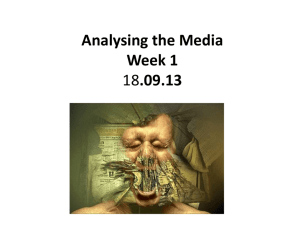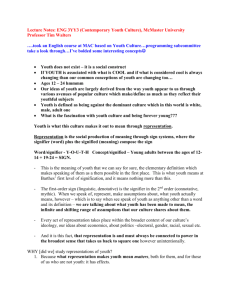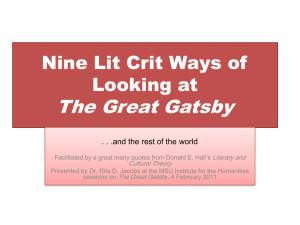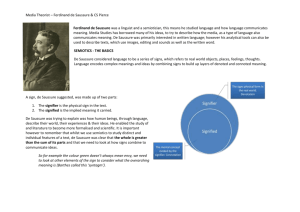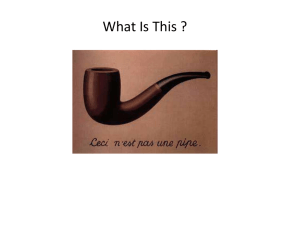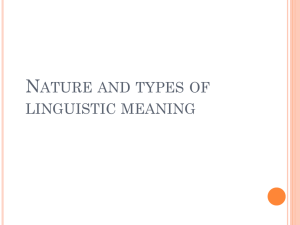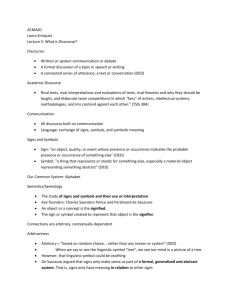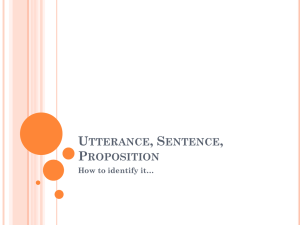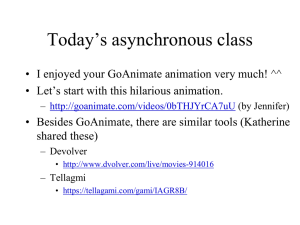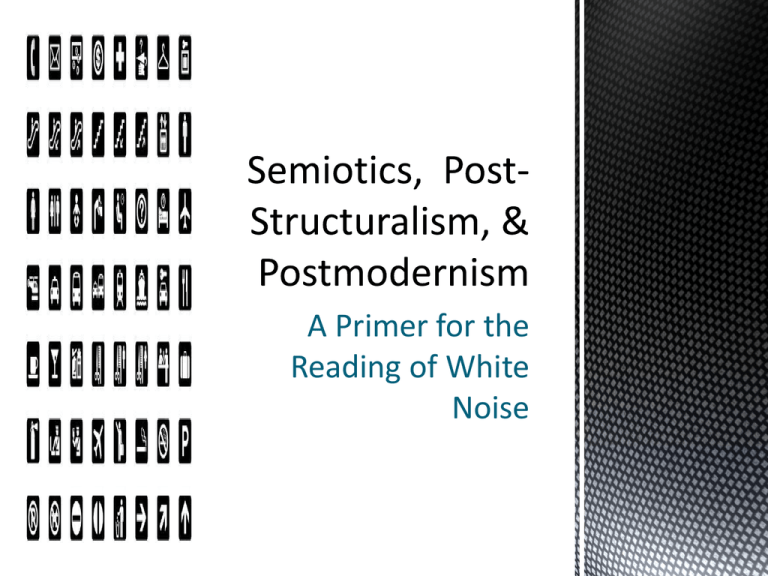
A Primer for the
Reading of White
Noise
At It’s core:
semiotics is the
study of signs and
how they work.
Semiotics is
concerned with
how we make
meaning and find
patterns of
organization.
Atomistic
Reality is composed of discrete,
irreducible units more real than the
whole.
VS
Organic
Reality is a totality where the
parts are real only in how they
relate to the whole.
PLATO (427-347 BC)
Words name concepts
and ideas
Words designate
essences
Words denote what all
things in that category
have in common (in
this example:
“treeness”
We call them trees . . .
Because that’s what
they are!!!! Are you
crazy or something?
PLATONIC HEAVEN:
the place of eternal,
unchanging truths
where the “real” exists
and where we
perceive only pale
copies here on earth.
THIS IS NOT A DESK
“For Plato, there is some natural connection between
words and concepts. Just as the word “writing” is like the
idea of writing, so is the word “dog” somehow like the
idea of a dog”
-Donald Palmer
•
•
•
•
Universal Meanings
Absolute Meanings
Unchanging Meanings
TRUTH exists (where does it come from?
That would be a silly question from this
type of mindset)
Semiotics: Now For Something Completely
Different!
Ferdinand De Saussure (1857-1913)
•
•
•
•
Language is made up of signs
Signified + Signifier =Sign
Signifier= a sound or image
Signified = an idea or a concept
This could be a “desk.”
The sign is completely
arbitrary. There is no logical
reason this has to be a tree.
“Tr-ee” is a phonetic sound
that has been agreed upon in
social, historical, and cultural
contexts to signify this thing.
Ramifications:
• Meaning can change over
time (“patriotism,”
“marriage,” “life”)
• Meaning is not contained in
a word or a thing itself but
in the relationship to an
entire system (more soon!)
A Desk
This doesn’t
have to be red.
These pieces
essentially “mean”
nothing.
They only mean once
they’re in the context
of a chess board.
And even then, they
only mean something
(i.e., a bishop moves
diagonally) if people
sitting at the board
have a consensus that
this is what they mean.
• Meaning is always absent
• Meaning is always dependent
The KEY
on an underlying system based
on negative relationships of
difference
This is not a bishop because IT IS a bishop.
It’s a bishop because it’s NOT a knight. It’s
NOT a Queen. It’s NOT a pawn.
It means “diagonal movement” because
other pieces don’t do that in the context of
a chess game.
Modernism
•
•
•
•
•
•
•
•
•
•
•
Form
Purpose
Design
Hierarchy
Art Object/Finished Work
Distance
Presence
Interpretation/Reading
Narrative
Paranoia/Alienation
Transcendence
Modernism (late 19th century to
mid 20th century) was a cultural
movement, or set of tendencies,
which rejected the earlier
“Enlightenment Project” which
focused on pure reason and
scientific method as the source of
all knowledge.
The modernist believed in “creative
destruction.” They feared the
institutions and morals of history
were stagnant and not in line with
an increasingly global and
technological world. In response,
they pursued utopic goals based on
radical new forms (experimental
fiction), tones (irony, satire), and a
foundational belief that high art and
reflection/analysis were the only
ways to understand (and live in) an
increasingly fractured world.
Roland Barthes 1915-1980
There are no “facts.”
No “have-to’s”
No “TRUTH.”
(how could there be? Where
does it come from? Even if we
pretend it exists, we can only
access it through language
whose meanings are never
present)
Connotation
• Puppy
• Satan
All that exists are signs
and social/personal
systems of encoding and
decoding signs.
Nietzsche “On Truth and Lie in an Extra-Moral Sense”
• Enlightenment Project has failed
• The focus on intellect and reason ignores the fact that the
intellect and reason operate through language; therefore,
even these things are merely constructions that cannot
reach an absolute truth
• Any “truth” will have a limited value. It can not be “true
in an of itself” or true apart from man.
• Our declarations and concepts are based in tautology. We
call a person “honest.” And when asked why he is honest
we reply, “He does honest things.” We have no access to
anything that is pure or true honesty- we operate on
individual instances and overlook anything that doesn’t
fit with out lived experience.
“What, then, is truth? A mobile army of metaphors, metonyms, and
anthromorphomisms- in short, a sum of human relations which have been
enhanced, transposed, and embellished poetically and rhetorically, and
which after long use seem firm, canonical, and obligatory to a people:
truths are illusions about which one has forgotten that this is what they
are; metaphors which are worn out and without sensuous power, coins
which have lost their pictures and now matter only as metal, no longer as
coins.”
“Man has an unconquerable tendency to let himself be deceived and he is
if enchanted with happiness when the rhapsodist tells him epic legends
are true or the actor plays the king more regally than any real monarch
does. As long as it can deceive without harm, the intellect, that master
of deception, is free and released.”
It Gets Worse
That’s too easy. Too tidy.
Although Saussure was
somewhat correct; his ideas
suggest a system of
language and meaning that
Is too closed and stable.
Derrida
Welcome to Post-Structuralism! Leave any Hopes for
Absolute Truth, Structures, or Clear Communication at
the Door
Saussure saw a direct and neat connection between the sign and the
signifier.
A desk may lead to different interpretations and connotations but you can
always count on the system of language connecting the signifier “apple”
with the signified of the spherical, tart fruit.
In post-structuralism, such order is no longer guaranteed or present.
Meaning is the slippery play of
endless signifiers signifying
something else. So meaning can
never truly be ascertained… just
assumed or self-deluded
LOVE
1. a profoundly tender, passionate affection for another person.
2. a feeling of warm personal attachment or deep affection, as for a
parent, child, or friend.
3. sexual passion or desire.
4. a person toward whom love is felt; beloved person; sweetheart.
Situationally Dependent Connotations:
•
•
•
•
Romance
Fear
Roses
Commitment
AFFECTION
1.
fond attachment, devotion, or love: the affection of a parent for
an only child.
2. Often, affections. a. emotion; feeling; sentiment: over and above our
reason and affections.
b. the emotional realm of love: a place in his affections.
3. Pathology . a disease, or the condition of being diseased; abnormal
state of body or mind: a gouty affection.
Situationally Dependent Connotations:
• Pre-conscious
• Terror
ATTACHMENT
1. an act of attaching or the state of being attached.
2. a feeling that binds one to a person, thing, cause, ideal, or the like;
devotion; regard: a fond attachment to his cousin; a profound
attachment to the cause of peace.
3. something that attaches; a fastening or tie: the attachments of a
harness; the attachments of a pair of skis.
4. an additional or supplementary device: attachments for an electric
drill.
Situationally Dependent Connotations:
• Work
• Claustophobia
Tender, Sex, Pathology,
Desire, Work,
Commitment, Fear,
Romance, Emotion,
Fondness,
Claustrophobia,
Unconscious, Sacrifice,
Heart, Life, Blood,
Mortality, etc. etc. etc.
Mcdonalds can’t control
this play of meanings.
Once language or signs
are public the
speaker/writer loses
control.
“Nothing is ever fully present in signs. It is an illusion for me to believe that I
can ever be fully present to you in what I say or write, because to use signs
at all entails that my meaning is always somehow dispersed, divided, and
never quite at one with itself. Not only my meaning, indeed, but me: since
language is something that I am made out of, rather then merely a
convenient tool that I use, the whole idea that I am a stable, unified entity
must also be a fiction. Not only can I never be fully present to you, but I can
never be fully present to myself either. I still need to use signs when I look
into my own mind or search my soul, and this means that I never
experience any “full communion” with myself.
It is not that I can have a pure, unblemished meaning, intention or
experience which then gets distorted and refracted by the flawed medium
of language because language is the very air I breath. I can never have a
pure, unblemished meaning or experience at all.”
-Terry Eagelton
Modernism versus Post-modernsim
•
•
•
•
•
•
•
•
•
•
•
Form
Purpose
Design
Hierarchy
Art Object/Finished Work
Distance
Presence
Interpretation/Reading
Narrative
Paranoia/Alienation
Transcendence
•
•
•
•
•
•
•
•
•
•
•
Anti-form
Play
Chance
Anarchy
Process/Becoming
Participation
Absence
Misreading
Anti-narrative
Schizophrenia
Immanence
The End of Hermeneutics and the Waning of Affect
Van Gough (Modern)
Warhol (Post-Modern)
The Commodified Image Itself, NOT a
Representation of a Real
Munch’s “The Scream.” A Classic Image of
Modern Art
Pomo Response:
Calm down scared,
alienated dude. You
don’t really possess a
“self” that is cohesive
enough to get so bent
out of shape. The
intensity of your emotion
is not owned by you;
rather, it is free floating
and impersonal.
In other words, chill out.
YOU are not that
important.
Historicism Effaces History
History: A sense of a lifeless re-telling of things that happened in the
past- told with the notion that the past can be looked back at objectively
as it “actually happened” and might possess universal truths that are
applicable to us now.
Historicism: The notion that to tell history is always to recreate history
from one’s own biased and subjective viewpoint.
History is the basis of META-NARRATIVES
& pomo, at its core (if it had a core), is
marked by incredulity to meta-narratives.
Meta-Narrative: Any story we tell ourselves about ourselves to make sense of the world,
to give us something to believe in, to organize chaos, to get us through the often unfaceable thought that there might be no truth, no absolute meaning, no purpose, etc. etc.
And This is The World of White Noise
• What happens in a world that is a constant bombardment of signs from all
directions at all moments?
• What happens when these signs broadcast through the media (especially
television)?
• What happens when there is no universal truth or center to look towards in
understanding this potentially overwhelming amount of signs?
• What happens when your own identity is nothing but language and signs that are
unstable, fluid, and (like writing) beyond your control or access?
All of these combined and put differently:
• What happens when language is all we really have (to think through, to
communicate through, to think, pray, love, hate, persuade, etc.), but language
itself is only signs referring to other signs that will forever prevent us any access to
anything real, true, or absolute.


